Click to view all Diesel Engine articles starting with the most recent.
 Beardmore Cyclone, Typhoon, and Simoon Aircraft Engines - The Beardmore Cyclone, Typhoon, and Simoon were a series of powerful, straight six- and straight eight-cylinder aircraft engines built in Britain in the 1920s. The large size of the engines limited their use.
Beardmore Cyclone, Typhoon, and Simoon Aircraft Engines - The Beardmore Cyclone, Typhoon, and Simoon were a series of powerful, straight six- and straight eight-cylinder aircraft engines built in Britain in the 1920s. The large size of the engines limited their use. Beardmore Tornado Diesel Airship Engine - The Beardmore Tornado was a 5,132 cu in (84.1 L), eight-cylinder, diesel engine that produced 650 hp (485 kw). Five Tornado engines powered the British R101 airship, which crashed in October 1930, killing 48 people.
Beardmore Tornado Diesel Airship Engine - The Beardmore Tornado was a 5,132 cu in (84.1 L), eight-cylinder, diesel engine that produced 650 hp (485 kw). Five Tornado engines powered the British R101 airship, which crashed in October 1930, killing 48 people.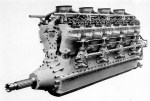 Clerget 16 H Diesel Aircraft Engine - The Clerget 16 H was a V-16 fitted with four turbosuperchargers. First run in 1939, the engine displaced 4,969 cu in (81.43 L), produced 2,000 hp (1,491 kW), and was intended to power transatlantic passenger aircraft.
Clerget 16 H Diesel Aircraft Engine - The Clerget 16 H was a V-16 fitted with four turbosuperchargers. First run in 1939, the engine displaced 4,969 cu in (81.43 L), produced 2,000 hp (1,491 kW), and was intended to power transatlantic passenger aircraft. Cummins Diesel Indy 500 Racers - The Cummins Engine Company used the Indianapolis 500 race to showcase its diesel engines as well as test new technology. Five cars competed in four races, and the best result was a 12th-place finish in 1934.
Cummins Diesel Indy 500 Racers - The Cummins Engine Company used the Indianapolis 500 race to showcase its diesel engines as well as test new technology. Five cars competed in four races, and the best result was a 12th-place finish in 1934.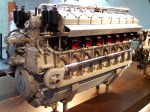 Daimler-Benz DB 602 (LOF-6) V-16 Diesel Airship Engine - The DB 602 V-16 was a world-class diesel airship engine built by Daimler-Benz in the 1930s. Because of the ill-fated Hindenburg and the end of the airship era, the engine never left a direct mark on history.
Daimler-Benz DB 602 (LOF-6) V-16 Diesel Airship Engine - The DB 602 V-16 was a world-class diesel airship engine built by Daimler-Benz in the 1930s. Because of the ill-fated Hindenburg and the end of the airship era, the engine never left a direct mark on history.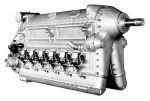 Deschamps V 3050 Diesel Aircraft Engine - The Deschamps V 3050 was an attempt to create a powerful diesel aircraft engine. The inverted V-12 engine produced 1,200 hp (895 kW) in 1934, but the lack of funds prevented the engine from being thoroughly tested.
Deschamps V 3050 Diesel Aircraft Engine - The Deschamps V 3050 was an attempt to create a powerful diesel aircraft engine. The inverted V-12 engine produced 1,200 hp (895 kW) in 1934, but the lack of funds prevented the engine from being thoroughly tested.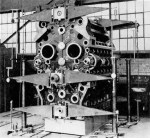 Fairbanks Morse Diamond Opposed-Piston Marine Engine - The Fairbanks Morse Diamond opposed-piston engine was an experimental project during WWII. Sponsored by the US Navy, the engine produced 3,000 hp, but only one prototype was built.
Fairbanks Morse Diamond Opposed-Piston Marine Engine - The Fairbanks Morse Diamond opposed-piston engine was an experimental project during WWII. Sponsored by the US Navy, the engine produced 3,000 hp, but only one prototype was built.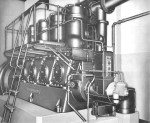 Fairbanks Morse Model 32 Stationary Engine - Production of the Fairbanks Morse Model 32 engine began in the mid-1920s. The engine was used to do everything from generating power to crushing rocks. Some Model 32 engines are still in use today.
Fairbanks Morse Model 32 Stationary Engine - Production of the Fairbanks Morse Model 32 engine began in the mid-1920s. The engine was used to do everything from generating power to crushing rocks. Some Model 32 engines are still in use today.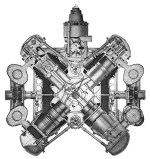 General Motors / Electro-Motive 16-184 Diesel Engine - The General Motors / Electro-Motive 16-184 was a vertical X-16 marine engine that produced 1,200 hp (895 kW). Because of its stacked cylinder configuration, it was nicknamed a pancake engine.
General Motors / Electro-Motive 16-184 Diesel Engine - The General Motors / Electro-Motive 16-184 was a vertical X-16 marine engine that produced 1,200 hp (895 kW). Because of its stacked cylinder configuration, it was nicknamed a pancake engine.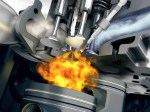 Inside the Cylinder of a Diesel Engine – by Harry Ricardo - Sir Harry Ricardo was one of the foremost engine designers and researchers of the internal combustion engine. In this article, he takes us through the first moments of combustion in a diesel engine.
Inside the Cylinder of a Diesel Engine – by Harry Ricardo - Sir Harry Ricardo was one of the foremost engine designers and researchers of the internal combustion engine. In this article, he takes us through the first moments of combustion in a diesel engine. Isotta Fraschini W-18 Aircraft and Marine Engines - In the 1920s and 1930s, Isotta Fraschini developed the Asso 750 and Asso 1000 W-18 aircraft engines. Although used in a number of aircraft, the engine found a much longer life in marine applications.
Isotta Fraschini W-18 Aircraft and Marine Engines - In the 1920s and 1930s, Isotta Fraschini developed the Asso 750 and Asso 1000 W-18 aircraft engines. Although used in a number of aircraft, the engine found a much longer life in marine applications.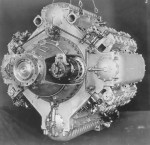 Junkers Jumo 223 Aircraft Engine - The Junkers Jumo 223 was a 24-cylinder, diesel, opposed-piston, aircraft engine. The 2,500 hp (1,860 kW) engine was intended to be used in long-range aircraft during WWII.
Junkers Jumo 223 Aircraft Engine - The Junkers Jumo 223 was a 24-cylinder, diesel, opposed-piston, aircraft engine. The 2,500 hp (1,860 kW) engine was intended to be used in long-range aircraft during WWII. Junkers Jumo 224 Aircraft Engine - Following the Jumo 223, Junkers designed a larger, 24-cylinder, diesel, opposed-piston, aircraft engine that was forecasted to produce 4,400 hp (3,280 kW). Taken over by the USSR after the war, the engine was redesignated M-224.
Junkers Jumo 224 Aircraft Engine - Following the Jumo 223, Junkers designed a larger, 24-cylinder, diesel, opposed-piston, aircraft engine that was forecasted to produce 4,400 hp (3,280 kW). Taken over by the USSR after the war, the engine was redesignated M-224.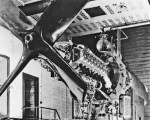 Klöckner-Humboldt-Deutz (KHD) Dz 700, Dz 710, and Dz 720 - Starting in the late 1930s and continuing through WWII, KHD built a series of two-stroke, diesel aircraft engines. The culmination of this effort was the 5,900 hp (4,400 kW), 32-cylinder KHD 720.
Klöckner-Humboldt-Deutz (KHD) Dz 700, Dz 710, and Dz 720 - Starting in the late 1930s and continuing through WWII, KHD built a series of two-stroke, diesel aircraft engines. The culmination of this effort was the 5,900 hp (4,400 kW), 32-cylinder KHD 720.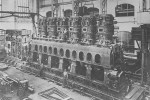 MAN Double-Acting Diesel Marine Engines - In the first half of the 20th century, MAN (Maschinenfabrik Augsburg-Nürnberg) developed a number of double-acting, two-stroke, diesel, marine engines, including a V-24 that displaced 224,957 cu in (3,686 L).
MAN Double-Acting Diesel Marine Engines - In the first half of the 20th century, MAN (Maschinenfabrik Augsburg-Nürnberg) developed a number of double-acting, two-stroke, diesel, marine engines, including a V-24 that displaced 224,957 cu in (3,686 L).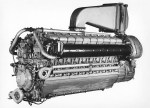 Mercedes-Benz 500 Series Diesel Marine Engines - The Mercedes-Benz MB 500 series diesel marine engines evolved from the Daimler-Benz DB 602 aviation engine and were first built in the 1930s. Some versions of MB 500 series are still in use today.
Mercedes-Benz 500 Series Diesel Marine Engines - The Mercedes-Benz MB 500 series diesel marine engines evolved from the Daimler-Benz DB 602 aviation engine and were first built in the 1930s. Some versions of MB 500 series are still in use today.  Michel Opposed-Piston Diesel Engines - Starting in the 1920s, German engineer Hermann Michel designed a series of opposed-piston engines. Michel’s ultimate design was an engine in which three pistons converged in a common combustion chamber.
Michel Opposed-Piston Diesel Engines - Starting in the 1920s, German engineer Hermann Michel designed a series of opposed-piston engines. Michel’s ultimate design was an engine in which three pistons converged in a common combustion chamber.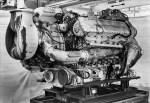 Napier Deltic Opposed-Piston Diesel Engine - The Napier Deltic was a two-stroke, opposed-piston diesel engine with three cylinder banks arranged in a triangle. The engine was developed in the 1950s for marine and locomotive use, and it is still used today.
Napier Deltic Opposed-Piston Diesel Engine - The Napier Deltic was a two-stroke, opposed-piston diesel engine with three cylinder banks arranged in a triangle. The engine was developed in the 1950s for marine and locomotive use, and it is still used today.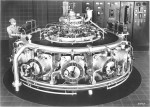 Nordberg Radial Stationary Engine - Starting in the late 1940s, the Nordberg Manufacturing Company built large 11- and 12-cylinder stationary radial engines primarily used to generate electricity and to run pumping stations.
Nordberg Radial Stationary Engine - Starting in the late 1940s, the Nordberg Manufacturing Company built large 11- and 12-cylinder stationary radial engines primarily used to generate electricity and to run pumping stations.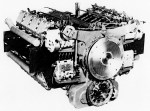 SGP Sla 16 (Porsche Type 203) X-16 Tank Engine - Designed by Porsche and Simmering-Graz-Pauker, the Sla 16 was a 750 hp (559 kW), air-cooled, diesel X-16 engine for tanks. The end of WWII prevented the German engine from going into production.
SGP Sla 16 (Porsche Type 203) X-16 Tank Engine - Designed by Porsche and Simmering-Graz-Pauker, the Sla 16 was a 750 hp (559 kW), air-cooled, diesel X-16 engine for tanks. The end of WWII prevented the German engine from going into production.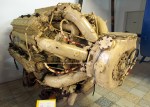 Yakovlev M-501 and Zvezda M503 and M504 Diesel Engines - One of the largest aircraft engines ever built, the 42-cylinder Yakovlev M-501 was modified into the Zvezda M503 marine engine. A further redesign created the 56-cylinder Zvezda M504.
Yakovlev M-501 and Zvezda M503 and M504 Diesel Engines - One of the largest aircraft engines ever built, the 42-cylinder Yakovlev M-501 was modified into the Zvezda M503 marine engine. A further redesign created the 56-cylinder Zvezda M504.